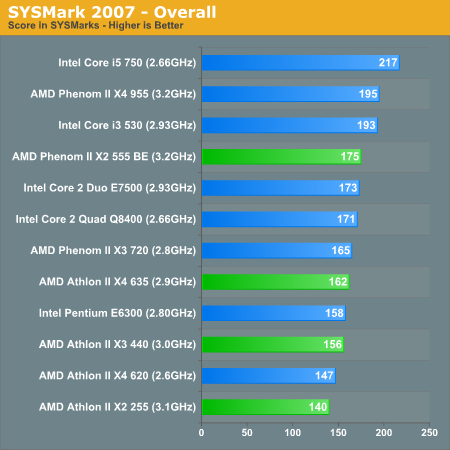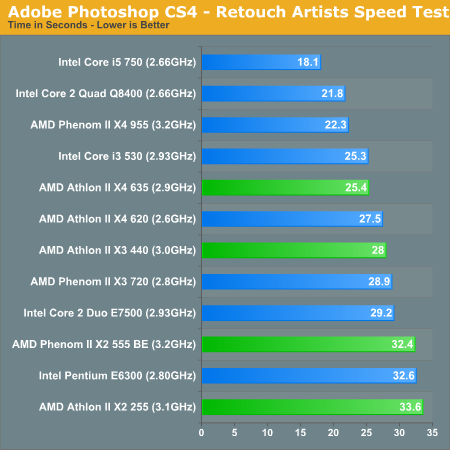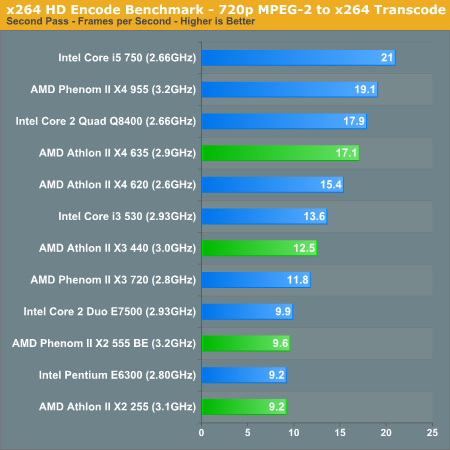AMD's New Year Refresh: Athlon II X4 635, Phenom II X2 555, Athlon II X2 255 & Athlon II X3 440
by Anand Lal Shimpi on January 25, 2010 12:00 AM EST- Posted in
- CPUs
SYSMark 2007 Performance
Our journey starts with SYSMark 2007, the only all-encompassing performance suite in our review today. The idea here is simple: one benchmark to indicate the overall performance of your machine.

Given its age, SYSMark is more of a lightly threaded benchmark by today's standards. Dual core processors (or quad-core chips with aggressive turbo modes) do quite well here. AMD's Phenom II X2 555 BE does better than anything else in its price range. The Core 2 Duo E7500 is probably a good indicator of the Pentium E6600's performance, and it just equals the perf of the 555 BE.
The triple and quad-core chips don't do that well here, there just aren't enough threads to go around.
Adobe Photoshop CS4 Performance
To measure performance under Photoshop CS4 we turn to the Retouch Artists’ Speed Test. The test does basic photo editing; there are a couple of color space conversions, many layer creations, color curve adjustment, image and canvas size adjustment, unsharp mask, and finally a gaussian blur performed on the entire image.
The whole process is timed and thanks to the use of Intel's X25-M SSD as our test bed hard drive, performance is far more predictable than back when we used to test on mechanical disks.
Time is reported in seconds and the lower numbers mean better performance. The test is multithreaded and can hit all four cores in a quad-core machine.

If you have threads and need cores, AMD has the medicine. The $119 Athlon II X4 635 handles our Photoshop test with the same elegance as Intel's Core i3 530. The Phenom II X2 555 BE and the Athlon II X2 255 are on par with the Pentium E6300 and should both be a bit slower than the E6600.
x264 HD Video Encoding Performance
Graysky's x264 HD test uses the publicly available x264 encoder to convert a 4Mbps 720p MPEG-2 source. The focus here is on quality rather than speed, thus the benchmark uses a 2-pass encode and reports the average frame rate in each pass.


For video-encoding you can't beat the value of the Athlon II X4 635. You get the performance of a quad-core Intel that will set you back another $40. The triple-core Athlon II X3 440 does well here, besting all previous generation dual-core CPUs. Only the Core i3 530 is faster, and more expensive. The Phenom II X2 555 BE and the Athlon II X2 255 perform similarly to their equivalently priced Intel CPUs.










63 Comments
View All Comments
mindless1 - Saturday, January 30, 2010 - link
Not necessarily, some e-series run any given frequency at a lower voltage, so by the same token whatever a non-e can do undervolted, an e- might do a bit higher speed at same voltage.Further, not all boards allow undervolting much, if at all, especially when you're trying to build a very small system. Big system with full mATX or ATX board with full o'c features, and silent fans is something just about any Tom, Dick, and Harry can build with no need to pick an e-series or undervolt a regular CPU.
play2learn - Monday, January 25, 2010 - link
Not everybody have up to date CPU:s. Anand, it would be fun if you sneak in an old processor like pentium 3, 4 or Pentium D next time.Taft12 - Wednesday, January 27, 2010 - link
Anand did just that back in when Phenom II X2 and Athlon II X2 were released:http://www.anandtech.com/cpuchipsets/showdoc.aspx?...">http://www.anandtech.com/cpuchipsets/showdoc.aspx?...
It was an embarrassment, no self-respecting hardware geek should be using that crap when the cheapest CPU and motherboard on the market today buries that stone-age technology.
mindless1 - Saturday, January 30, 2010 - link
... but to many geeks, it's the love of tech, not the ePenis you claim by virtue of your system performance.I mean really, there is a point where even a geek takes a sensible position about what is appropriate for the work or play they actually do. Would you be amazed to know I still have a Celeron 500MHz fileserver running? The geek in me made it right in the first place including beefed up mobo capacitors, very open heatsink that takes years to get appreciable dust in it, filtered intake/positive pressure, and a few others things faster, but inferior for the purpose, systems have today.
mindless1 - Saturday, January 30, 2010 - link
lol, meant ... DON'T usually have today.play2learn - Thursday, January 28, 2010 - link
You have a point there. But then there are people like me that's still not satisfied with today's technology and just sit and wait and wait for that ultimate experience to show up. If you want me to buy a new system today (which is not going to happen) I need to be humiliated more than once.ssj4Gogeta - Monday, January 25, 2010 - link
Won't it skew the graphs (eg. a bar too long to fit or a bar too small to be visible)NJoy - Monday, January 25, 2010 - link
Sure it would. Last week just out of curiosity I decided to run CinebenchR10 on a Dell Precision with dual Xeons (PD 3Ghz based, 4 threads) against C2D E8400. Guest what? Over 4 minutes for Xeons whilst about 2:20 for C2D. Humiliation...mattscottshea - Monday, January 25, 2010 - link
These are assumptions made by current naming standards. However, if these were to hold true, it would be quite a coup by AMD as there current unreleased top of the line 975 will run at 3.6GHz with 4 cores at 140W using the C3 stepping.AMD Phenom II X6 1075T 3.6GHz 6 cores / 125W (D1 stepping?)
AMD Phenom II X6 1055T 3.2GHz 6 cores / 95W
AMD Phenom II X6 1035T 2.9GHz 6 cores / 95W
AMD Phenom II X4 960T 3.3GHz 4 cores / 95W
MrSpadge - Monday, January 25, 2010 - link
LOL. Naming conventions are there to lure people into buying just when you break the convention (*looking at the greenteam*)Anyway, their process has not magically changed - otherwise todays CPUs would be more energy efficient. And a new stepping is not going to turn the world upside down.. maybe a gain of 5% power at similar settings and a slightly higher clock speed at similar power levels.
And today you're getting 4 cores at 3.4 GHz for 140 / 125W. They'll be lucky and need heavy speed binning to get 3 GHz at 140W for the best 6-core CPU.